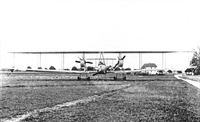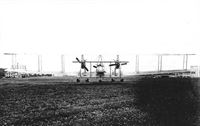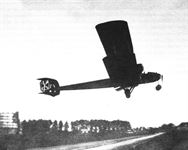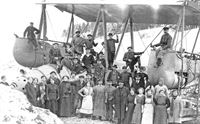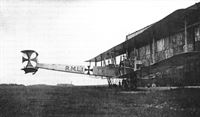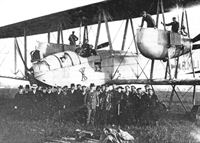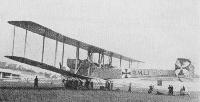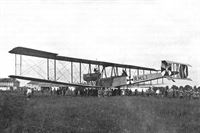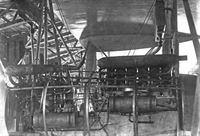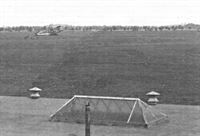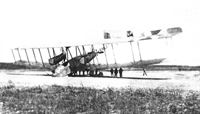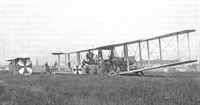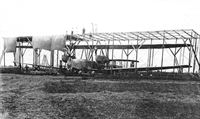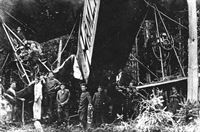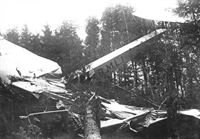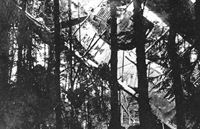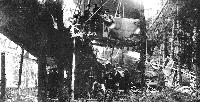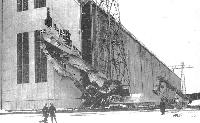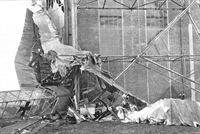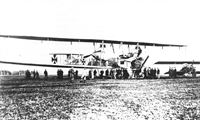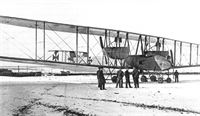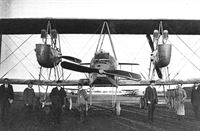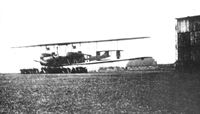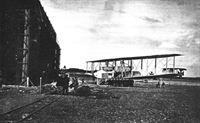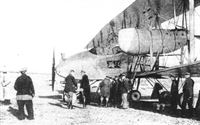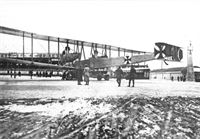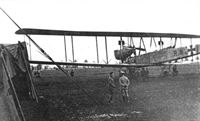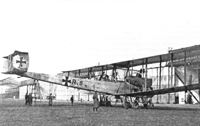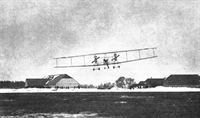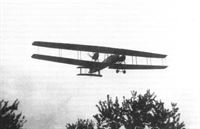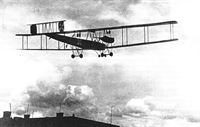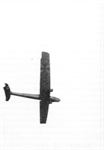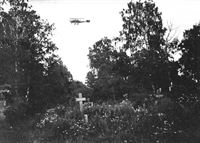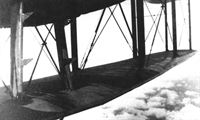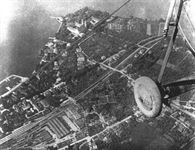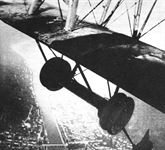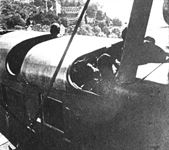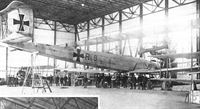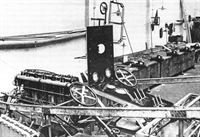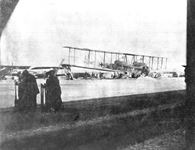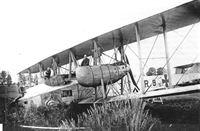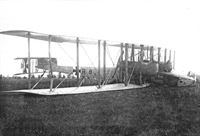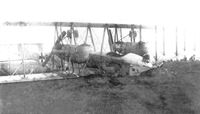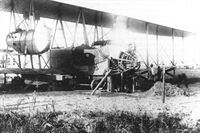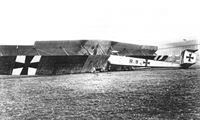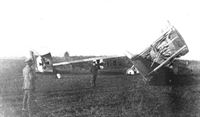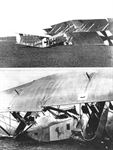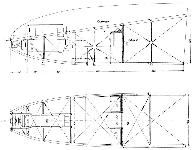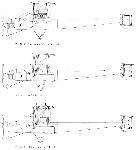
Описание
Страна: Германия
Год: 1915
Бомбардировщик
Варианты
- Zeppelin-Staaken - VGO.I/VGO.II - 1915 - Германия
- Zeppelin-Staaken - R.V - 1916 - Германия
- Zeppelin-Staaken - VGO.III / R.IV / R.VII - 1916 - Германия
- В.Кондратьев Самолеты первой мировой войны
- O.Thetford, P.Gray German Aircraft of the First World War (Putnam)
- G.Haddow, P.Grosz The German Giants (Putnam)
- J.Herris Zeppelin-Staaken Aircraft of WW1. Vol 1: VGO.1 - R.IV R.29/16 (A Centennial Perspective on Great War Airplanes 47)
- M.Dusing German Aviation Industry in WWI. Volume 2 (A Centennial Perspective on Great War Airplanes 85)
-
J.Herris - Zeppelin-Staaken Aircraft of WW1. Vol 1: VGO.1 - R.IV R.29/16 /Centennial Perspective/ (47)
Staaken VGO.I after being rebuilt as the R.M.L.1
-
J.Herris - Zeppelin-Staaken Aircraft of WW1. Vol 1: VGO.1 - R.IV R.29/16 /Centennial Perspective/ (47)
Staaken VGO.I in final configuration with partial Cellon covering.
-
J.Herris - Zeppelin-Staaken Aircraft of WW1. Vol 1: VGO.1 - R.IV R.29/16 /Centennial Perspective/ (47)
Staaken's first R-plane (R for Reisenflugzeug, or Giant airplane), the VGO.I in its original configuration; a Halberstadt B.I at right and the men give scale to the aircraft.The basic configuration, the wings, and the horizontal tail remained basically unchanged for Staaken bombers throughout the war. Note the four short fins and rudders. Amazingly, design of this aircraft began in December 1914, just 11 years after the first flight of the Wright brothers. Its wing span of 138.5' exceeded the 120' distance of the Wright's first flight. Each of its three propellers was powered by a 240 hp Maybach HS engine. Designed for airships, the HS engines were unreliable in airplanes due to the higher average power airplanes needed. (Peter M. Grosz collection/STDB)
All three VGO aircraft have been built at Versuchsbau Gotha Ost. Here is shown the VGO.I before reconstruction. Later, as "R.M.L.1", it got movable machine guns in the engine nacelles operated by the mechanics. A series of crash landings, due to the too weak and overtaxed engines resulted in a series of rebuilds. Instead of three 240 hp Maybach HS engine the improved VGO.I had 4 245 hp Maybach Mb.IVa and two 160 hp Mercedes D.III engines in the nose. Finally, after a brief service at the front in 1916 as a naval bomber, the VGO.I was reengined by five 245 hp Maybach Mb.IVa. During the first flight after the final rebuild on March 10,1917, the left engine failed. Vollmoller had to push hard on the rudder, which jammed in the final position, and the aircraft turned to the right toward the hangar. Karl Kuring, another test pilot, had already complained days before that the lateral control was not working properly, recognized the danger and tried to pull the pedal into the normal position with his hands, but too late, the plane crashed into the hangar, testpilots Vollmoller and Gustav Klein were dead.Другие самолёты на фотографии: Halberstadt B.I/B.II/B.III/C.I - Германия - 1915
-
J.Herris - Zeppelin-Staaken Aircraft of WW1. Vol 1: VGO.1 - R.IV R.29/16 /Centennial Perspective/ (47)
Staaken's first R-plane, the VGO.I. The overall configuration was conventional, if very large, for its time. The double interplane cables are faired without first being drawing together as they were on all later types. VGO engineers are standing in front of the aircraft; from left to right they are Hans Baumeister, Philipp Simon, and Foreman Hungs. (Peter M. Grosz collection/STDB)
-
J.Herris - Zeppelin-Staaken Aircraft of WW1. Vol 1: VGO.1 - R.IV R.29/16 /Centennial Perspective/ (47)
Staaken's first R-plane, the VGO.I. The V.G.O. It normally operated on its nose landing gear but it also had a tail skid in case it needed one, as shown here. (Peter M. Grosz collection/STDB)
-
J.Herris - Zeppelin-Staaken Aircraft of WW1. Vol 1: VGO.1 - R.IV R.29/16 /Centennial Perspective/ (47)
Staaken's first R-plane, the VGO.I in its original configuration; the men give scale to the aircraft. The basic configuration, the wings, and the horizontal tail remained basically unchanged throughout the war. The aft engine cowling panels are not yet fitted. (Peter M. Grosz collection/STDB)
-
J.Herris - Zeppelin-Staaken Aircraft of WW1. Vol 1: VGO.1 - R.IV R.29/16 /Centennial Perspective/ (47)
Staaken's first R-plane, the VGO.I. The V.G.O. It normally operated on its nose landing gear but it also had a tail skid in case it needed one, as shown here. (Peter M. Grosz collection/STDB)
-
J.Herris - Zeppelin-Staaken Aircraft of WW1. Vol 1: VGO.1 - R.IV R.29/16 /Centennial Perspective/ (47)
Staaken's first R-plane, the VGO.I under inspection by a group of men, probably VIPs. (Peter M. Grosz collection/STDB)
-
J.Herris - Zeppelin-Staaken Aircraft of WW1. Vol 1: VGO.1 - R.IV R.29/16 /Centennial Perspective/ (47)
Staaken's first R-plane, the VGO.I. The 240 hp Maybach HS engines fitted were the most powerful aeroengines available in Germany at the time, but they were very unreliable and significantly hindered R-plane development. (Peter M. Grosz collection/STDB)
-
J.Herris - Zeppelin-Staaken Aircraft of WW1. Vol 1: VGO.1 - R.IV R.29/16 /Centennial Perspective/ (47)
Staaken's first R-plane, the VGO.I. The tail configuration included four small fins and rudders. Here the wing-mounted engines are running without their aft cowlings, making the engines visible. (Peter M. Grosz collection/STDB)
-
J.Herris - Zeppelin-Staaken Aircraft of WW1. Vol 1: VGO.1 - R.IV R.29/16 /Centennial Perspective/ (47)
Staaken's first R-plane, the VGO.I in the hangar in its original configuration without aft engine cowlings. (Peter M. Grosz collection/STDB)
-
J.Herris - Zeppelin-Staaken Aircraft of WW1. Vol 1: VGO.1 - R.IV R.29/16 /Centennial Perspective/ (47)
Staaken's first R-plane, the VGO.I, in its initial configuration with four short fins and rudders and missing aft engine cowlings. (Peter M. Grosz collection/STDB)
-
J.Herris - Zeppelin-Staaken Aircraft of WW1. Vol 1: VGO.1 - R.IV R.29/16 /Centennial Perspective/ (47)
Staaken's first R-plane, the VGO.I. The 240 hp Maybach HS engines fitted were the most powerful aeroengines available in Germany at the time, but they were very unreliable and significantly hindered R-plane development. (Peter M. Grosz collection/STDB)
-
J.Herris - Zeppelin-Staaken Aircraft of WW1. Vol 1: VGO.1 - R.IV R.29/16 /Centennial Perspective/ (47)
Staaken's first R-plane, the VGO.I in its original configuration; the men give scale to the aircraft. The basic configuration, the wings, and the horizontal tail remained basically unchanged throughout the war. The aft engine cowling panels are not yet fitted. (Peter M. Grosz collection/STDB)
-
J.Herris - Zeppelin-Staaken Aircraft of WW1. Vol 1: VGO.1 - R.IV R.29/16 /Centennial Perspective/ (47)
Staaken's first R-plane, the VGO.I, on its maiden flight on April 11, 1915. (Peter M. Grosz collection/STDB)
-
J.Herris - Zeppelin-Staaken Aircraft of WW1. Vol 1: VGO.1 - R.IV R.29/16 /Centennial Perspective/ (47)
Staaken's first R-plane, the VGO.I photographed in flight from another aircraft. (Peter M. Grosz collection/STDB)
-
J.Herris - Zeppelin-Staaken Aircraft of WW1. Vol 1: VGO.1 - R.IV R.29/16 /Centennial Perspective/ (47)
The V.G.O. I being modified in the factory. (Peter M. Grosz collection/STDB)
-
G.Haddow, P.Grosz - The German Giants /Putnam/
The VGO.I in the autumn of 1915 after the engine nacelles were modified and the four short rudders and fins replaced by two tall fins and rudders. (Peter M. Grosz collection/STDB)
-
J.Herris - Zeppelin-Staaken Aircraft of WW1. Vol 1: VGO.1 - R.IV R.29/16 /Centennial Perspective/ (47)
The VGO.I in the autumn of 1915 after the engine nacelles were modified and the four short fins and rudders replaced by two tall fins and rudders. (Peter M. Grosz collection/STDB)
-
J.Herris - Zeppelin-Staaken Aircraft of WW1. Vol 1: VGO.1 - R.IV R.29/16 /Centennial Perspective/ (47)
The VGO.I in the autumn of 1915 after the engine nacelles were modified and the four short rudders and fins replaced by two tall fins and rudders. (Peter M. Grosz collection/STDB)
-
J.Herris - Zeppelin-Staaken Aircraft of WW1. Vol 1: VGO.1 - R.IV R.29/16 /Centennial Perspective/ (47)
The VGO.I in the autumn of 1915 after the engine nacelles were modified and the four short fins and rudders replaced by two tall fins and rudders. (Peter M. Grosz collection/STDB)
-
J.Herris - Zeppelin-Staaken Aircraft of WW1. Vol 1: VGO.1 - R.IV R.29/16 /Centennial Perspective/ (47)
The VGO.I in the autumn of 1915 after the engine nacelles were modified and the four short fins and rudders replaced by two tall fins and rudders. (Peter M. Grosz collection/STDB)
-
J.Herris - Zeppelin-Staaken Aircraft of WW1. Vol 1: VGO.1 - R.IV R.29/16 /Centennial Perspective/ (47)
The VGO.I in the autumn of 1915 after the engine nacelles were modified and the four short fins and rudders replaced by two tall fins and rudders. (Peter M. Grosz collection/STDB)
-
J.Herris - Zeppelin-Staaken Aircraft of WW1. Vol 1: VGO.1 - R.IV R.29/16 /Centennial Perspective/ (47)
The V.G.O.I after modifications. There are now two tall fins and rudders. An Albatros B.II is in left foreground. (Peter M. Grosz collection/STDB)
Другие самолёты на фотографии: Albatros B.II - Германия - 1914
-
J.Herris - Zeppelin-Staaken Aircraft of WW1. Vol 1: VGO.1 - R.IV R.29/16 /Centennial Perspective/ (47)
The VGO.I in the autumn of 1915 after the engine nacelles were modified and the four short fins and rudders were replaced by two taller fins and rudders. (Peter M. Grosz collection/STDB)
-
J.Herris - Zeppelin-Staaken Aircraft of WW1. Vol 1: VGO.1 - R.IV R.29/16 /Centennial Perspective/ (47)
The VGO.I in the autumn of 1915 after the engine nacelles were modified and the four short fins and rudders were replaced by two taller fins and rudders. (Peter M. Grosz collection/STDB)
-
J.Herris - Zeppelin-Staaken Aircraft of WW1. Vol 1: VGO.1 - R.IV R.29/16 /Centennial Perspective/ (47)
The VGO.I in the autumn of 1915 after the engine nacelles were modified and the four short fins and rudders were replaced by two taller fins and rudders. (Peter M. Grosz collection/STDB)
-
J.Herris - Zeppelin-Staaken Aircraft of WW1. Vol 1: VGO.1 - R.IV R.29/16 /Centennial Perspective/ (47)
The V.G.O.I after modifications. (Peter M. Grosz collection/STDB)
-
J.Herris - Zeppelin-Staaken Aircraft of WW1. Vol 1: VGO.1 - R.IV R.29/16 /Centennial Perspective/ (47)
The VGO.I after it crashed in the Thuringen Forest on 15 December 1915. (Peter M. Grosz collection/STDB)
-
J.Herris - Zeppelin-Staaken Aircraft of WW1. Vol 1: VGO.1 - R.IV R.29/16 /Centennial Perspective/ (47)
The VGO.I after it crashed in the Thuringen Forest on 15 December 1915. The crash severely damaged the aircraft but there were no injuries to the crew. (Peter M. Grosz collection/STDB)
-
J.Herris - Zeppelin-Staaken Aircraft of WW1. Vol 1: VGO.1 - R.IV R.29/16 /Centennial Perspective/ (47)
The VGO.I after it crashed in the Thuringen Forest on 15 December 1915. The crash was caused by failure of two engines after their oil lines failed during a severe snowstorm. Unable to maintain altitude on one engine, pilots Hans Vollmoller and Flugmaat Willy Mann skillfully landed in a small forest clearing with no injuries to the crew. (Peter M. Grosz collection/STDB)
-
J.Herris - Zeppelin-Staaken Aircraft of WW1. Vol 1: VGO.1 - R.IV R.29/16 /Centennial Perspective/ (47)
The VGO.I after it crashed in the Thuringen Forest. Here it is being dismantled to move the parts back to the factory to rebuild the aircraft. (Peter M. Grosz collection/STDB)
-
J.Herris - Zeppelin-Staaken Aircraft of WW1. Vol 1: VGO.1 - R.IV R.29/16 /Centennial Perspective/ (47)
The VGO.I was rebuilt after it crashed in the Thuringen Forest. It included some modifications that had already be applied to the VGO.II, which had been completed by this time. The rebuilt VGO.I was assigned to the Navy as the R.M.L.1 (Reichs Marine Landflugzeug 1 = Reich Navy Landplane 1).The designation was painted on both sides of the fuselage in large characters. The rebuilt VGO.I now featured flexible machine gun positions in the forward part of the rebuilt engine nacelles. A large gravity fuel tank was added to the underside of the upper wing and became a feature of later Zeppelin-Staaken designs. The fins were enlarged and the rudders were aerodynamically balanced. (Peter M. Grosz collection/STDB)
-
J.Herris - Zeppelin-Staaken Aircraft of WW1. Vol 1: VGO.1 - R.IV R.29/16 /Centennial Perspective/ (47)
The VGO.I after being rebuilt as the R.M.L.1. (Peter M. Grosz collection/STDB)
-
J.Herris - Zeppelin-Staaken Aircraft of WW1. Vol 1: VGO.1 - R.IV R.29/16 /Centennial Perspective/ (47)
The VGO.I/R.M.L.1 on an airfield. (Peter M. Grosz collection/STDB)
-
J.Herris - Zeppelin-Staaken Aircraft of WW1. Vol 1: VGO.1 - R.IV R.29/16 /Centennial Perspective/ (47)
The VGO.I after being rebuilt as the R.M.L.1. (Peter M. Grosz collection/STDB)
-
J.Herris - Zeppelin-Staaken Aircraft of WW1. Vol 1: VGO.1 - R.IV R.29/16 /Centennial Perspective/ (47)
The VGO.II (R.9/15) at right and the R.M.L.1 on the airfield together.The location is probably Alt-Auz on the Eastern Front. (Peter M. Grosz collection/STDB)
-
O.Thetford, P.Gray - German Aircraft of the First World War /Putnam/
V.G.O. I. Attendant personnel lend scale showing how collossal these machines really were.
-
J.Herris - Zeppelin-Staaken Aircraft of WW1. Vol 1: VGO.1 - R.IV R.29/16 /Centennial Perspective/ (47)
The VGO.I after being rebuilt as the R.M.L.1. (Peter M. Grosz collection/STDB)
-
J.Herris - Zeppelin-Staaken Aircraft of WW1. Vol 1: VGO.1 - R.IV R.29/16 /Centennial Perspective/ (47)
The RML.I as used on operations over the Eastern Front.
-
J.Herris - Zeppelin-Staaken Aircraft of WW1. Vol 1: VGO.1 - R.IV R.29/16 /Centennial Perspective/ (47)
The VGO.I after its final rebuild with two 245 hp Maybach Mb.IVa engines in each wing nacelle. (Peter M. Grosz collection/STDB)
-
J.Herris - Zeppelin-Staaken Aircraft of WW1. Vol 1: VGO.1 - R.IV R.29/16 /Centennial Perspective/ (47)
The VGO.I/R.M.L.1 has experienced a taxi accident. (Peter M. Grosz collection/STDB)
-
J.Herris - Zeppelin-Staaken Aircraft of WW1. Vol 1: VGO.1 - R.IV R.29/16 /Centennial Perspective/ (47)
The VGO.I/R.M.L.1 after the nose gear collapsed at Schneidemuhl on the journey to Alt-Auz, June 1916. (Peter M. Grosz collection/STDB)
-
J.Herris - Zeppelin-Staaken Aircraft of WW1. Vol 1: VGO.1 - R.IV R.29/16 /Centennial Perspective/ (47)
Mishap with the rebuilt VGO.I (RML.I), during the take-off at Schneidemuhl for the journey to Alt-Auz, June 1916
-
J.Herris - Zeppelin-Staaken Aircraft of WW1. Vol 1: VGO.1 - R.IV R.29/16 /Centennial Perspective/ (47)
A further mishap to the RML.I en route to the Front. Undercarriage failure on the airfield at Konigsberg.
-
J.Herris - Zeppelin-Staaken Aircraft of WW1. Vol 1: VGO.1 - R.IV R.29/16 /Centennial Perspective/ (47)
The VGO.I/R.M.L.1 suffered a landing gear collapse at Konigsberg enroute to the front. (Peter M. Grosz collection/STDB)
-
J.Herris - Zeppelin-Staaken Aircraft of WW1. Vol 1: VGO.1 - R.IV R.29/16 /Centennial Perspective/ (47)
The VGO.I/R.M.L.1 suffered a landing gear collapse at Konigsberg enroute to the front. (Peter M. Grosz collection/STDB)
-
J.Herris - Zeppelin-Staaken Aircraft of WW1. Vol 1: VGO.1 - R.IV R.29/16 /Centennial Perspective/ (47)
The VGO.I/R.M.L.1 suffered a landing gear collapse at Konigsberg enroute to the front. (Peter M. Grosz collection/STDB)
-
J.Herris - Zeppelin-Staaken Aircraft of WW1. Vol 1: VGO.1 - R.IV R.29/16 /Centennial Perspective/ (47)
Temporary shelter being erected over the VGO.I/R.M.L.1 while under repair at Konigsberg. (Peter M. Grosz collection/STDB)
-
J.Herris - Zeppelin-Staaken Aircraft of WW1. Vol 1: VGO.1 - R.IV R.29/16 /Centennial Perspective/ (47)
VGO.I/R.M.L.1 under repair in the temporary shelter at Konigsberg. (Peter M. Grosz collection/STDB)
-
J.Herris - Zeppelin-Staaken Aircraft of WW1. Vol 1: VGO.1 - R.IV R.29/16 /Centennial Perspective/ (47)
The land-based Riesenflugzeug (Giant Aeroplane) was evaluated as a possible addition to the naval airship for bombing and long-range scouting purposes. However, experience with RML1 (Reichs Navy Landplane 1) was plagued with difficulties. Engine troubles and structural failures of undercarriage assemblies were eventually overcome and the aircraft participated in some bombing operations on the Eastern Front, until, on a fully loaded night take-off late in August 1916, a double engine failure resulted in this crash into a Russian forest.
-
J.Herris - Zeppelin-Staaken Aircraft of WW1. Vol 1: VGO.1 - R.IV R.29/16 /Centennial Perspective/ (47)
The crash of the R.M.L.1 into a pine forest. The R.M.L.1 had just taken off at night with a full load of fuel and bombs when, at 50 meters altitude, two engines "exploded". The pilots Kuring and Mann guided the plane into the pine forest where it sheared off 69 trees, cushioning the crash and preventing fire. (Peter M. Grosz collection/STDB)
-
J.Herris - Zeppelin-Staaken Aircraft of WW1. Vol 1: VGO.1 - R.IV R.29/16 /Centennial Perspective/ (47)
The crash of the R.M.L.1 into a pine forest. The fuselage was salvaged and sent back to Staaken where it was again rebuilt, with new wings and engines. The three unreliable HS engines were replaced with five new 245 hp Maybach Mb.IVa engines, one in the nose and two in each nacelle. (Peter M. Grosz collection/STDB)
-
G.Haddow, P.Grosz - The German Giants /Putnam/
Crash of the RML.I in the forest near Alt-Auz on 28 August 1916.
-
G.Haddow, P.Grosz - The German Giants /Putnam/
Earlier we left RML1 in a Russian forest... The machine was completely rebuilt and was modified to take an additional two engines. At this time a transparent Cellon covering to reduce the effect of searchlight illumination was under consideration and the fuselage and tail unit were covered with this material. On the first test flight on 10 March 1917, at Staaken aerodrome near Berlin, engine failure resulted in an asymmetric flight condition, which was compounded by a control system malfunction. The pilots could not prevent the machine from crashing into the corner of one of the airship sheds.
-
J.Herris - Zeppelin-Staaken Aircraft of WW1. Vol 1: VGO.1 - R.IV R.29/16 /Centennial Perspective/ (47)
View of the final crash of the final version of the VGO I at Staaken on March 10, 1917. This was the maiden flight of the final rebuild of the aircraft. The take-off went smoothly but as the aircraft was circling the field, an explosion was heard from the left nacelle and the left propeller stopped. The pilots corrected with hard right rudder and the VGO I responded by flying in a straight line to enable it to land parallel to the airship sheds. While familiarizing himself with the controls three days earlier, Kuring, the usual second pilot, had discovered and reported that the rudder controls were networking normally. In a hard-over position the rudder pedals jammed and could not be returned to the neutral position for landing. This problem had not been repaired and the crew's pre-flight inspection had not been thorough enough to rediscover it. As Vollmoller reduced power to land, the rudder remained jammed in the hard-right position and the plane started to turn right. Kuring immediately unfastened his safety belt and crept under the instrument panel to pull the rudder pedals over from their jammed position. He was not able to do this in time and the VGO I smashed head-on into the door of the airship shed. First pilot Hans Vollmoller was killed instantly and acting second pilot Gustav Klein died after a few hours. Kuring was thrown out by the impact and suffered severe head injuries. However, eventually he was able to rejoin his unit, Marine Jasta 2, and enjoyed a long aeronautical career. However, the VGO I was a total loss and was not rebuilt. When the VGO I was rebuilt for the final time, the new fuselage and tail were covered in transparent Cellon in an early attempt to make the airplane partly invisible and this is seen in the crash photos on these pages. A top secret report showing with pictures that Cellon covering greatly reduced visibility of aircraft in the air but the fragility and water absorption of Cellon covering make it unusable in operational conditions. The Unsichtbare Flugzeug (Low Visibility Aircraft) program for giant bombers was discontinued after tests. The Linke-Hofmann R.I 8/15 was also tested with extensive Cellon covering as part of this program. (Peter M. Grosz collection/STDB)
-
J.Herris - Zeppelin-Staaken Aircraft of WW1. Vol 1: VGO.1 - R.IV R.29/16 /Centennial Perspective/ (47)
View of the final crash of the final version of the VGO I at Staaken on March 10, 1917. This was the maiden flight of the final rebuild of the aircraft. The take-off went smoothly but as the aircraft was circling the field, an explosion was heard from the left nacelle and the left propeller stopped. The pilots corrected with hard right rudder and the VGO I responded by flying in a straight line to enable it to land parallel to the airship sheds. While familiarizing himself with the controls three days earlier, Kuring, the usual second pilot, had discovered and reported that the rudder controls were networking normally. In a hard-over position the rudder pedals jammed and could not be returned to the neutral position for landing. This problem had not been repaired and the crew's pre-flight inspection had not been thorough enough to rediscover it. As Vollmoller reduced power to land, the rudder remained jammed in the hard-right position and the plane started to turn right. Kuring immediately unfastened his safety belt and crept under the instrument panel to pull the rudder pedals over from their jammed position. He was not able to do this in time and the VGO I smashed head-on into the door of the airship shed. First pilot Hans Vollmoller was killed instantly and acting second pilot Gustav Klein died after a few hours. Kuring was thrown out by the impact and suffered severe head injuries. However, eventually he was able to rejoin his unit, Marine Jasta 2, and enjoyed a long aeronautical career. However, the VGO I was a total loss and was not rebuilt. When the VGO I was rebuilt for the final time, the new fuselage and tail were covered in transparent Cellon in an early attempt to make the airplane partly invisible and this is seen in the crash photos on these pages. A top secret report showing with pictures that Cellon covering greatly reduced visibility of aircraft in the air but the fragility and water absorption of Cellon covering make it unusable in operational conditions. The Unsichtbare Flugzeug (Low Visibility Aircraft) program for giant bombers was discontinued after tests. The Linke-Hofmann R.I 8/15 was also tested with extensive Cellon covering as part of this program. (Peter M. Grosz collection/STDB)
-
J.Herris - Zeppelin-Staaken Aircraft of WW1. Vol 1: VGO.1 - R.IV R.29/16 /Centennial Perspective/ (47)
The VGO.II (R.9/15) probably taken at Dobertiz prior to its service on the Eastern Front. (Peter M. Grosz collection/ STDB)
-
J.Herris - Zeppelin-Staaken Aircraft of WW1. Vol 1: VGO.1 - R.IV R.29/16 /Centennial Perspective/ (47)
The VGO.II (R.9/15) probably taken at Dobertiz prior to its service on the Eastern Front.. (Peter M. Grosz collection/STDB)
-
J.Herris - Zeppelin-Staaken Aircraft of WW1. Vol 1: VGO.1 - R.IV R.29/16 /Centennial Perspective/ (47)
The VGO.II (R.9/15) in service in the snow. (Peter M. Grosz collection/STDB)
-
J.Herris - Zeppelin-Staaken Aircraft of WW1. Vol 1: VGO.1 - R.IV R.29/16 /Centennial Perspective/ (47)
The VGO.II being admired by VIPs. (Peter M. Grosz collection/STDB)
-
J.Herris - Zeppelin-Staaken Aircraft of WW1. Vol 1: VGO.1 - R.IV R.29/16 /Centennial Perspective/ (47)
The VGO.II (R.9/15) on its airfield after modification with fixed fin. The cabin has also been modified. (Peter M. Grosz collection/STDB)
-
J.Herris - Zeppelin-Staaken Aircraft of WW1. Vol 1: VGO.1 - R.IV R.29/16 /Centennial Perspective/ (47)
The VGO.II (R.9/15) on its airfield after modification with fixed fin. (Peter M. Grosz collection/STDB)
-
J.Herris - Zeppelin-Staaken Aircraft of WW1. Vol 1: VGO.1 - R.IV R.29/16 /Centennial Perspective/ (47)
The VGO.II (R.9/15) in service on the Eastern Front. (Peter M. Grosz collection/STDB)
-
J.Herris - Zeppelin-Staaken Aircraft of WW1. Vol 1: VGO.1 - R.IV R.29/16 /Centennial Perspective/ (47)
The VGO.II on the Adlershof airfield. (Peter M. Grosz collection/STDB)
-
J.Herris - Zeppelin-Staaken Aircraft of WW1. Vol 1: VGO.1 - R.IV R.29/16 /Centennial Perspective/ (47)
The VGO.II (R.9/15) in service on the Eastern Front. (Peter M. Grosz collection/STDB)
-
J.Herris - Zeppelin-Staaken Aircraft of WW1. Vol 1: VGO.1 - R.IV R.29/16 /Centennial Perspective/ (47)
VGO.II at the factory. The fixed fin is not visible which indicates the aircraft is in its original as-built condition. (Peter M. Grosz collection/STDB)
-
J.Herris - Zeppelin-Staaken Aircraft of WW1. Vol 1: VGO.1 - R.IV R.29/16 /Centennial Perspective/ (47)
VGO.II in flight at the factory, perhaps after takeoff. (Peter M. Grosz collection/STDB)
-
J.Herris - Zeppelin-Staaken Aircraft of WW1. Vol 1: VGO.1 - R.IV R.29/16 /Centennial Perspective/ (47)
The massive VGO.II (R.9/15) in flight. (Peter M. Grosz collection/STDB)
-
M.Dusing - German & Austro-Hungarian Aero Engines of WWI. Vol.3 /Centennial Perspective/ (66)
The massive VGO.II in flight illustrates the basic configuration of the Zeppelin-Staaken R-planes. Compared to the VGO.I, the VGO.II had a modified tail; the rudders were enlarged and reduced to two instead of four, and a large fixed fin was added to improve stability. The engine nacelles were in final form with provision for flexible guns. (Peter M. Grosz collection/STDB)
The VGO.II, like the very similar VGO.I, was powered by three Maybach HS engines. Designed to power airships, the HS engines were not compatible with the greater average power needs of aircraft; the higher stresses associated with powering aircraft resulted in many engine failures. Both the VGO.I and VGO.II crashed due to failure of their HS engines. -
J.Herris - Zeppelin-Staaken Aircraft of WW1. Vol 1: VGO.1 - R.IV R.29/16 /Centennial Perspective/ (47)
The massive VGO.II (R.9/15) in flight November 5, 1915. (Peter M.Grosz collection/STDB)
-
J.Herris - Zeppelin-Staaken Aircraft of WW1. Vol 1: VGO.1 - R.IV R.29/16 /Centennial Perspective/ (47)
The VGO.II (R.9/15) in flight in its original configuration without fixed fin. (Peter M. Grosz collection/STDB)
-
J.Herris - Zeppelin-Staaken Aircraft of WW1. Vol 1: VGO.1 - R.IV R.29/16 /Centennial Perspective/ (47)
The VGO.II (R.9/15) in flight photographed from the ground. (Peter M. Grosz collection/STDB)
-
J.Herris - Zeppelin-Staaken Aircraft of WW1. Vol 1: VGO.1 - R.IV R.29/16 /Centennial Perspective/ (47)
The VGO.II (R.9/15) in flight with a cemetery in the foreground. Perhaps the composition of the photograph represented the photographer’s opinion of aviators' fate. (Peter M. Grosz collection/STDB)
-
J.Herris - Zeppelin-Staaken Aircraft of WW1. Vol 1: VGO.1 - R.IV R.29/16 /Centennial Perspective/ (47)
The starboard engine nacelle of the VGO.II with its Maybach HS. (Peter M. Grosz collection/STDB)
-
J.Herris - Zeppelin-Staaken Aircraft of WW1. Vol 1: VGO.1 - R.IV R.29/16 /Centennial Perspective/ (47)
The VGO.II (R.9/15) in flight photographed from its cockpit. (Peter M. Grosz collection/STDB)
-
J.Herris - Zeppelin-Staaken Aircraft of WW1. Vol 1: VGO.1 - R.IV R.29/16 /Centennial Perspective/ (47)
The port outer wing photographed from the cockpit in flight. (Peter M. Grosz collection/STDB)
-
J.Herris - Zeppelin-Staaken Aircraft of WW1. Vol 1: VGO.1 - R.IV R.29/16 /Centennial Perspective/ (47)
In-flight photo taken from the left nacelle of the VGO.II. (Peter M. Grosz collection/STDB)
-
J.Herris - Zeppelin-Staaken Aircraft of WW1. Vol 1: VGO.1 - R.IV R.29/16 /Centennial Perspective/ (47)
The VGO.II (R.9/15) photographed from its cockpit while in flight. (Peter M. Grosz collection/STDB)
-
J.Herris - Zeppelin-Staaken Aircraft of WW1. Vol 1: VGO.1 - R.IV R.29/16 /Centennial Perspective/ (47)
The VGO.II (R.9/15) after cabin modification in flight photographed from the port nacelle. (Peter M. Grosz collection/STDB)
-
J.Herris - Zeppelin-Staaken Aircraft of WW1. Vol 1: VGO.1 - R.IV R.29/16 /Centennial Perspective/ (47)
The VGO.II (R.9/15) under construction at the factory. The fixed fin was not present at this stage. (Peter M. Grosz collection/STDB)
-
J.Herris - Zeppelin-Staaken Aircraft of WW1. Vol 1: VGO.1 - R.IV R.29/16 /Centennial Perspective/ (47)
The cockpit and nose of the VGO.II being built. (Peter M. Grosz collection/STDB)
-
J.Herris - Zeppelin-Staaken Aircraft of WW1. Vol 1: VGO.1 - R.IV R.29/16 /Centennial Perspective/ (47)
The VGO.II (R.9/15) under construction at the factory. The fixed fin was not present at this stage. (Peter M. Grosz collection/STDB)
-
J.Herris - Zeppelin-Staaken Aircraft of WW1. Vol 1: VGO.1 - R.IV R.29/16 /Centennial Perspective/ (47)
The VGO.II undergoing maintenance after an accident involving landing gear failure.
-
J.Herris - Zeppelin-Staaken Aircraft of WW1. Vol 1: VGO.1 - R.IV R.29/16 /Centennial Perspective/ (47)
The VGO.II (R.9/15) after a landing accident at Paulsgnade in late 1916. Fuel exhaustion due to a strong headwind returning from a bombing mission forced the plane down at a fighter field and it rolled into a ditch at the end of the runway. (Peter M. Grosz collection/STDB)
-
J.Herris - Zeppelin-Staaken Aircraft of WW1. Vol 1: VGO.1 - R.IV R.29/16 /Centennial Perspective/ (47)
The VGO.II (R.9/15) after a landing accident at Paulsgnade near Mitau in late 1916. Fuel exhaustion due to a strong headwind returning from a bombing mission forced the plane down at a fighter field and it rolled into a ditch at the end of the runway. (Peter M. Grosz collection/STDB)
-
J.Herris - Zeppelin-Staaken Aircraft of WW1. Vol 1: VGO.1 - R.IV R.29/16 /Centennial Perspective/ (47)
VGO.II under repair at Paulsgnade after its accident. Repairs took only a few days. (Peter M. Grosz collection/STDB)
-
J.Herris - Zeppelin-Staaken Aircraft of WW1. Vol 1: VGO.1 - R.IV R.29/16 /Centennial Perspective/ (47)
Assigned the military serial number R.9/15, here is the VGO.II after its last landing in the summer of 1917. It was assigned as a trainer at the Rea in Doberitz on January 1, 1917. The records do not indicate any fatalities and the photo shows the aircraft did not catch fire when it crashed, so there were no known casualties. Note the raised tail surfaces. (Peter M. Grosz collection/STDB)
-
G.Haddow, P.Grosz - The German Giants /Putnam/
Forward engine arrangement or the VGO.I and VGO.II.
-
J.Herris - Weird Wings of WWI /Centennial Perspective/ (70)
Drawing of the 105 mm cannon installation planned for the VGO II. The actual cannon mounted was a 130 mm gun. Ground firing trials were held on 6 and 10 October 1916 followed by an airborne firing trial on 19 October with satisfactory results. The gun was intended to penetrate the deck armor of British warships, including battleships. (Peter M. Grosz collection/STDB).
В.Кондратьев Самолеты первой мировой войны
На рубеже 1914-1915 годов сразу несколько германских авиафирм практически одновременно приступили к созданию крупных многомоторных бомбардировочных аэропланов. Наибольших успехов в этом деле добился коллектив, возглавляемый выдающимся инженером-дирижаблестроителем графом Фердинандом Цеппелином. К работе над проектом Цеппелин привлек целую плеяду талантливых ученых. Среди них были Эрнст Хейнкель, Клаудио Дорнье, Адольф Рорбах, Хельмут Хирт, чьи имена впоследствии прославили немецкую авиацию. Строительство первых летающих гигантов проходило на основанной Цеппелином совместно с Густавом Кляйном и Робертом Бошем фирме Фершухс Гота Ост (Versuchs Gotha Ost, сокращенно - VGO). Позднее VGO объединилась с фирмой Штаакен, также возглавлявшейся графом Цеппелином. Всего за годы войны было создано 16 модификаций аэропланов VGO и "Цеппелин-Штаакен" (не считая гидросамолетов), две из которых выпускались серийно. Большинство из этих машин заслуживает отдельного описания.
МОДИФИКАЦИИ
VGO-I и VGO-II. Первый экспериментальный образец с заводским индексом VGO-I впервые поднялся в воздух 11 апреля 1915 года. Это был многостоечный цельнодеревянный биплан с двойным оперением и полотняной обшивкой. На момент создания VGO-I - крупнейший самолет в мире.
Два двигателя "Майбах" Mb.IV по 240 л.с. с толкающими винтами размещались в каплевидных мотогондолах, еще один такой же мотор с тянущим винтом - в носовой части фюзеляжа. В передних частях гондол предусматривалась установка пулеметных турелей. Шасси трехопорное с носовой стойкой. Экипаж - 7 человек: 2 пилота, 3 механика (по одному на каждый мотор) и 2 стрелка.
После успешного облета машины на заводском аэродроме ее отправили для войсковых испытаний на восточный фронт. Затем самолет вернули на фирму, где с целью повышения энерговооруженности установили в мотогондолы еще два "Майбаха" в тандем к предыдущим. Таким образом аппарат стал пятимоторным.
В одном из испытательных полетов модернизированный VGO-I потерпел катастрофу и не восстанавливался. VGO-II был практически идентичен с VGO-I в его раннем, трехмоторном варианте. Самолет также использовался в 1916 году на русско-германском фронте, а затем -в качестве учебной машины.
Описание:






















